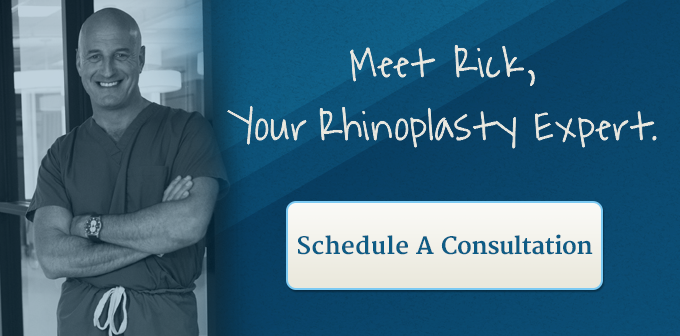You can’t completely avoid post rhinoplasty swelling after your nose job, as it’s part of the healing process. A closed rhinoplasty has less swelling than an open one, due to the lack of an external incision. The amount that you swell depends on many factors, including your body chemistry, the extent of your procedure and how well you follow postoperative instructions. It could take up to a year for swelling to go away completely, however, there are a few ways to speed up the healing process and reduce your post rhinoplasty swelling.
Use Cold Compresses as Directed
One of the best things you can do for your post rhinoplasty swelling is to apply a cold compress according to the post-surgical instructions. In general, you don’t want to put the cold compress directly on your nose during the initial healing stage. By placing it on your cheeks, you can bring down the swelling without compromising the dressing on your nose. You can use it more directly after you no longer have any drainage coming from the incision sites.
Take Over-the-Counter Anti-Inflammatory Medicine
You may need to abstain from anti-inflammatory medication before your surgery, but you can lessen the swelling when you are cleared to take them during the healing process. The pain levels also go down when the swelling is handled proactively. The best over-the-counter medication depends on your NJ surgeon’s recommendations, with NSAIDs commonly used for this purpose. If you’re prescribed other painkillers after your surgery, check with your doctor to confirm that they won’t interfere.
Eat Healthy Food
After major surgery on your nose, your body needs the time to recuperate. To avoid post rhinoplasty swelling, a healthy diet is an important part of giving your body the fuel it needs to heal quickly. Make sure that you drink enough water to stay hydrated, as this also helps to reduce the visibility of any scar tissue.
Several types of food have anti-inflammatory properties that can help your nose swelling go down. Green leafy vegetables are an excellent choice during your recovery period, as are fatty fish and fruits. Nuts are another high protein option to mix in.
Try to limit the amount of processed food that you eat. Some ingredients can cause more inflammation, such as fried food. Anything containing sugar is also a problem. It may be difficult to eliminate sugar entirely from your diet, as it’s included in many dishes.
Use Proper Sleeping Position
Sleeping flat on your back doesn’t allow proper drainage for your nose incisions. During the first few days after the surgery, you need to keep your nose higher than your heart. You can get past the initial discomfort faster by sleeping in a recliner or using an incline pillow for elevated rest. If you can continue to sleep in this position for a week or two post-surgery, you’ll be in good shape on the swelling front. Ensure that you don’t put any pressure on your nose as you sleep, as this could cause a shift in the work that your NJ surgeon performed. Side sleeping is not recommended, as you could easily end up with your nose in an awkward position.
Follow Activity Guidelines
You can’t jump right back into daily activities after rhinoplasty. Take it easy for a few days immediately following the surgery. You’ll be in the most pain at this part in the healing process, and a lot of swelling is normal. Don’t worry about bruising by your eyes, as this is a typical side effect of a nose job.
Avoid strenuous activity for two weeks after your surgery. While you can enjoy light exercise, you want to take your time. Blowing your nose is another thing you need to stay away from. This action puts too much strain on the new structures in this area. Mucus buildup and drainage make it difficult to stay away from this temptation, but a saline solution keeps your nostrils clear while they heal up.
Do you wear glasses? Resting eyeglasses on the bridge of your nose puts too much strain, so it’s important to use an alternative arrangement. Contact lenses work the best for this purpose, but you can also support the middle of your glasses through a small piece of tape. Don’t try to put your glasses on normally for two weeks after the rhinoplasty. Once you’re past the point of the worst swelling, use your lightest lenses and be ready to switch back to another method if you end up in pain.
What to Do If the Post Rhinoplasty Swelling Is Severe
Discomfort, pain and swelling are commonplace following this surgery. However, you should feel an improvement after the first few days. If the swelling seems to be getting worse or isn’t reacting to self-care, talk to your doctor. In some cases, you may need a steroid injection to help the area heal and return to a normal appearance.
You can’t eliminate swelling after you get a nose job, but you have many ways to limit the pain and address the side effects. Once you complete the post-surgery healing process, you’re going to love the result. You have to wait up to a year for the swelling to go away completely, but you’ll see a significant decrease after the first two to three weeks.


